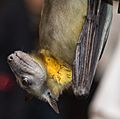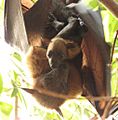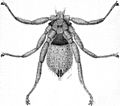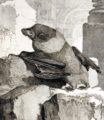Megabat facts for kids
Quick facts for kids Megabats |
|
|---|---|
 |
|
| Large flying fox, Pteropus vampyrus | |
| Scientific classification | |
| Kingdom: | |
| Phylum: | |
| Class: | |
| Order: | |
| Suborder: |
Megachiroptera
|
| Family: |
Pteropodidae
Gray, 1821
|
| Subfamilies | |
|
Macroglossinae |
|
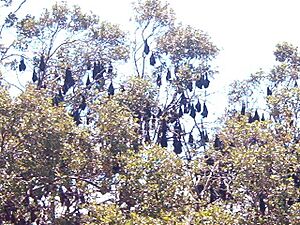
Megabats are also known as Old World fruit bats or Flying Foxes. They are a special group of bats called the suborder Megachiroptera, which belongs to the family Pteropodidae.
These amazing flying mammals live in thick forests. You can find them in Africa, Europe, Australia, and Asia. There are about 166 different kinds of fruit bats. These bats live in huge groups called "camps." They are nocturnal, which means they are most active at night. During the day, they rest by hanging upside down from their feet.
Contents
What Megabats Do for Plants
As fruit bats fly around looking for food, they help plants in two important ways. First, they help to pollinate plants. This is like carrying pollen from one flower to another, which helps the plants make seeds. Second, they help to disperse (spread) seeds as they eat.
Many plants need these bats to help them grow. This includes some avocados, dates, mangos, and peaches. Without fruit bats, these plants would have a harder time making new plants.
How Megabats Find Food
Fruit bats mostly drink fruit juice and flower nectar. When they eat fruit, they chew it up. Then, they spit out the seeds, peel, and pulp.
Fruit bats, like other megabats, use their strong sense of smell to find their food. Even though they have big eyes and can see well, smell is their main way to find tasty fruits and nectar.
Megabats and Viruses
Some megabats can carry dangerous viruses. These viruses can sometimes make people sick. It's important to remember that getting sick from a bat is very rare.
Important Viruses from Bats
The Ebola virus was first found in humans in 1976. Scientists are still learning where it came from. Recent tests show that some fruit bats can carry the Ebola virus without getting sick themselves. This means bats might be the original source of the virus. The Marburg virus, which is like Ebola, has also been found in fruit bats in Uganda.
In Australia, flying foxes can carry two other serious viruses. These are the Australian bat lyssavirus and the Hendra virus. These viruses are very rare but can be very dangerous.
Hendra virus mainly affects megabats. It can also spread to horses. Horses might get the virus by eating food or drinking water that has bat fluids on it. The virus can be deadly for both horses and humans.
Staying Safe Around Bats
It is very important to remember that human infections from these viruses are very rare. The best way to stay safe is to avoid touching or handling flying foxes. If you see a bat that looks sick or is on the ground, do not touch it. Instead, tell an adult or call an animal rescue group.
Related Pages
Images for kids
-
The spotted-winged fruit bat (Balionycteris maculata)
-
The straw-coloured fruit bat (Eidolon helvum)
-
The long-tongued fruit bat (Macroglossus sobrinus)
-
Wahlberg's epauletted fruit bat (Epomophorus wahlbergi)
-
Contrasting yellow mantle of the Mariana fruit bat (Pteropus mariannus)
-
Skull of the black-eared flying fox (Pteropus melanotus)
-
Skeleton of the Samoa flying fox (Pteropus samoensis)
-
Internal anatomy of the hammer-headed bat (Hypsignathus monstrosus)
-
The reddish-orange eyes of the Fijian monkey-faced bat (Mirimiri acrodonta)
-
A Lyle's flying fox (Pteropus lylei) with offspring
-
Indian flying fox (Pteropus medius) in flight
-
An example of a bat fly, a flightless fly that parasitizes bats, including megabats
-
The Egyptian fruit bat (Rousettus aegyptiacus), which has tested positive for Marburg virus and antibodies against the Ebola virus, though not the actual virus.
-
A flying fox depicted in indigenous Australian art
See also
 In Spanish: Pteropódidos para niños
In Spanish: Pteropódidos para niños




